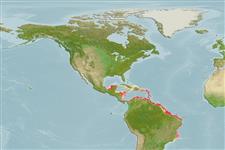Common names from other countries
Environment: milieu / climate zone / depth range / distribution range
Ecologia
marinhas demersal; intervalo de profundidade 1 - 36 m (Ref. 13608). Tropical; 22°N - 24°S, 97°W - 30°W
Western Atlantic: southern Gulf of Mexico and West Indies to Santos, Brazil.
Length at first maturity / Tamanho / Peso / Idade
Maturity: Lm 58.8, range 50 - 55 cm
Max length : 200 cm WD macho/indeterminado; (Ref. 3168); common length : 125 cm WD macho/indeterminado; (Ref. 6077)
Disc rhomboid. Blunt and close-set tubercles that clothe the midzone of disc. Snout in front of eyes about 1.4 times as long as distance between outer margins of orbits. Upper surface brown, sometimes yellowish or olivaceous. Lower surface pure or yellowish white, ventral tail fold and dorsal keel black (Ref. 6902).
Demersal species on continental shelf to at least 35 m (but likely to be deeper); also found in brackish water, with young collected from tide pools (Ref. 114953). Mobile invertebrate feeders, feeds on benthic mobile invertebrates such as molluscs, crustaceans and worms associated with hard or nearby unconsolidated substrate (Ref. 103985); also on small fishes (Ref. 114953). Ovoviviparous (Ref. 50449). Marketed salted; also used in the preparation of gelatin and good quality oil. Between 1995 and 2000, at least 5 specimens have been traded as aquarium fish at Ceará, Brazil (Ref. 49392).
Exhibit ovoviparity (aplacental viviparity), with embryos feeding initially on yolk, then receiving additional nourishment from the mother by indirect absorption of uterine fluid enriched with mucus, fat or protein through specialised structures (Ref. 50449). Distinct pairing with embrace (Ref. 205).
Last, P.R., W.T. White, M.R. de Carvalho, B. Séret, M.F.W. Stehmann and G.J.P. Naylor, 2016. Rays of the world. CSIRO Publishing, Comstock Publishing Associates. i-ix + 1-790. (Ref. 114953)
Categoria na Lista Vermelha da IUCN (Ref. 130435)
CITES (Ref. 128078)
Not Evaluated
Ameaça para o homem
Traumatogenic (Ref. 3168)
Utilização humana
Pescarias: pouco comercial
Ferramentas
Relatórios especiais
Descarregue XML
Fontes da internet
Estimates based on models
Preferred temperature (Ref.
115969): 26.7 - 28.2, mean 27.6 (based on 565 cells).
Phylogenetic diversity index (Ref.
82804): PD
50 = 0.5039 [Uniqueness, from 0.5 = low to 2.0 = high].
Bayesian length-weight: a=0.01202 (0.00696 - 0.02076), b=3.06 (2.91 - 3.21), in cm Total Length, based on LWR estimates for this species & (Sub)family-body (Ref.
93245).
Nível Trófico (Ref.
69278): 4.3 ±0.3 se; based on diet studies.
Resiliência (Ref.
120179): Muito baixo, tempo mínimo de duplicação da população maior que 14 anos (Fec=2).
Fishing Vulnerability (Ref.
59153): Very high vulnerability (90 of 100).
